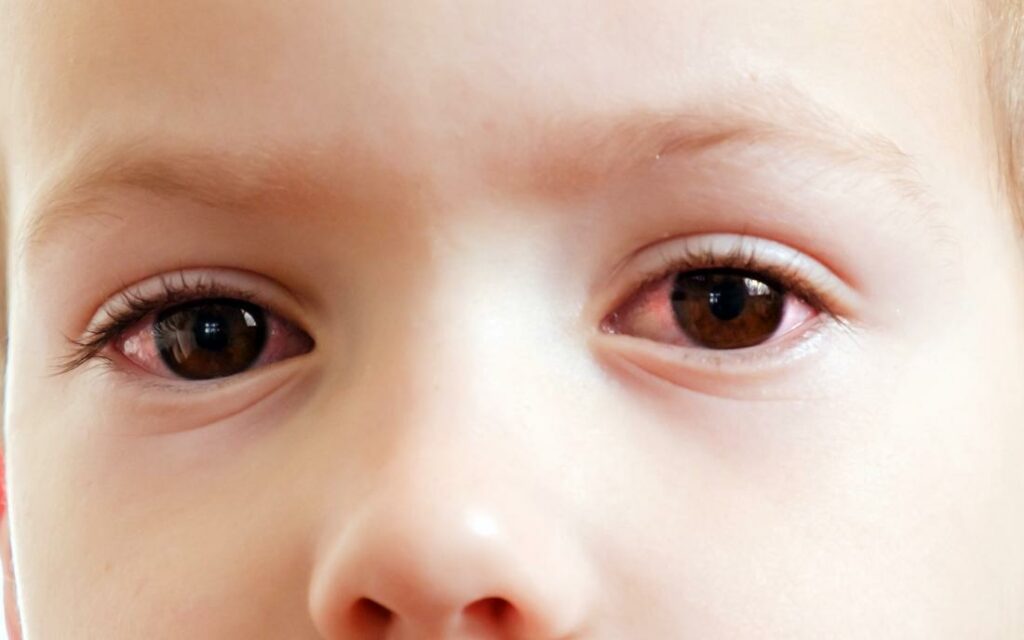If you didn’t know already, you must be aware now that red eyes are a common and repetitive problem in tiny babies. There are some reasons why your baby has developed red eyes, and to determine that, you must observe the potential signs and symptoms.
A visit to the doctor will reveal how mild or severe the case has been. Red and bloodshot eyes are a cause of concern, mainly if they have appeared despite your baby not crying or if they have been around for too long. Pinkeye (known as conjunctivitis), which we will discuss in this article, is mostly to blame for red, itchy eyes. However, other causes that manifest the appearance of red eyes can’t be ignored.
Hence, in this article, we will be exploring conjunctivitis and other reasons in great detail.
Conjunctivitis
Conjunctivitis or pinkeye is quite common in babies, toddlers, and adults. It is a frequent case in babies, mainly because they tend to rub their eyes and touch anything within their reach. It is also best to remember that pinkeye can appear in either one or both eyes.
Simply put, conjunctivitis is the inflammation in the conjunctiva of the eye. The conjunctiva is the clear, thin membrane that lines the inner side of the eye and the outer coating too. It could be either bacterial or viral conjunctivitis. Usually, this condition resolves within a period, but sometimes it persists, instilling panic.
Causes
When it comes to the causes of conjunctivitis, there are multiple reasons why this condition tends to attack. Some of the significant causes of conjunctivitis are:
- Entering a foreign object in the eye
- Allergens
- Incompletely opened or blocked tear ducts in babies
- Irritating things (such as shampoos, dirt, chlorine found commonly in swimming pools)
If you have pinkeye that a bacteria or virus has caused, they are easily spread by shaking or touching other people’s hands. Even touching surfaces and not thoroughly washing your hands can cause the germs to pass or travel easily. For women, conjunctivitis can happen if they use old, expired makeup or apply it with unclean or dirty tools.
Symptoms
As mentioned before, bacterial conjunctivitis is very different from viral conjunctivitis. Viral conjunctivitis (better known as pinkeye) has symptoms such as red eyelids, watery, puffy eyes, and redness in the area where it is supposed to be white.
However, bacterial conjunctivitis is way more severe than viral conjunctivitis. A thick, sticky, yellow paste-like discharge comes through the eyes in bacterial conjunctivitis. Because of this sticky discharge, the eyelids and the eyelashes may stick together.
More symptoms include increased tearing and irritation, blurry vision, burning eyes, itchy and swollen eyes and increased sensitivity to any source of light.
Diagnosis
For a doctor, it may be hard to reveal the real cause of conjunctivitis, but he’ll be able to diagnose the disease as per the child’s symptoms. The doctor may throw many different questions relating to the infant’s health.
Apart from the child’s health questions, the doctor may also ask whether your child wears glasses or whether anyone near the child has been exposed to pink eye. If your child has been suffering from the disease frequently, or if his symptoms don’t seem to tone down, then the doctor may send some samples to the laboratory for further investigation.
It is most likely that a vision test may be held to inspect whether the vision has been affected or not.
Treatment
The first steps to treatment are some preventive majors that you as a parent must immediately take when your child is diagnosed with conjunctivitis (whether it is viral or bacterial). Foremost, it would be best if you avoided irritants such as smoke, pollen, and dust. These, along with other known allergens, must be kept out, and your child should be taken care of properly, as anything can trigger conjunctivitis at an increasing pace.Rinse the eyes properly with lukewarm water if the buildup gets too much around the eyes. Try cold compresses as that can aid in cooling the inflamed and swollen eyes. Even ice packs are a good option for soothing those puffy eyes and the area around them.
If the baby isn’t comfortable with cold compresses, you can go for warm compresses. However, you must ensure that the compress isn’t scorching; otherwise, it may worsen the symptoms. Also, ensure that the compress is comfortably warm for the baby to put on the eyes. Moreover, it would be best to limit your child’s contact with others for a while. This way, there will be fewer chances of the disease spreading out. You can also put in instruction; your child cannot rub their eyes with their bare hands. Instead, you should teach the use of a clean cloth.
Other Causes Of Red Eyes
We must explore more causes as to why babies end up with red eyes other than conjunctivitis.
Frequent Rubbing
In small babies, this is normal and quite repetitive. However, since the skin around the eyes is the most delicate and tends to rub real hard and deep, it can cause veiny and red eyes. If this is a habit that your baby has just picked up, then you either try mittens or wait for it to resolve.
Allergic Conjunctivitis
As the name goes, allergic conjunctivitis causes teary, red, and irritating eyes. This can occur due to any irritants that bug the eye and cause the conjunctiva to swell. Due to the allergic reaction, this can cause red eyes, but typically that is not the case.
Corneal Abrasion
A corneal abrasion is a superficial scratch on the cornea. It can happen due to dust, sand, dirt, contact lenses or even a tiny paper corner. Some of the signs that point that your baby has corneal abrasion are pain, teary eyes, and sensitivity to light.
Conclusion
Babies are a source of worry with almost anything they do. Though redness around the eyes is a common problem, it would be better to visit the doctor to avoid any complications if it doesn’t sit right in a few days. Or if your little one seems to be in discomfort, then you shouldn’t ignore it.



Recent Comments